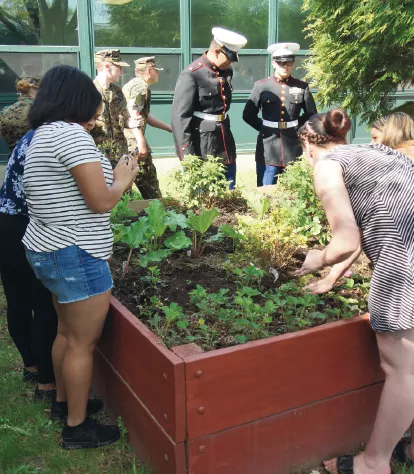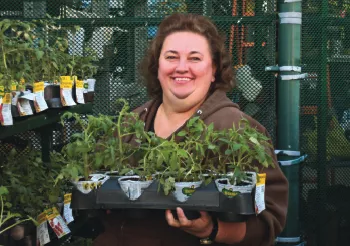For members of Haverhill High School’s Garden Club, spring clean- ing means more than dusting furniture and shaking rugs. After a harsh Massachusetts winter, their seasonal task instead is to rake dead leaves, prune drooping branches, and dispose of dead organic matter that blankets the school’s award-winning garden.
“In April, we will take our garden supplies and benches out of stor- age,” says paraeducator Nancy Burke, who founded the garden in 2012 for special needs students. “Before we begin planting seeds, we have to till and turn soil that has been compacted by months of ice and snow.”
These are the first steps at Haverhill as students prepare for Spring Planting Day on May 15.
“My goal when I started the garden was to teach students where food comes from and encourage them to make healthy food choices,” says Burke, a member of the Haverhill Education Association.
The project started in a school courtyard with a single bed of tomato plants, peppers, and oregano. It was called the salsa garden. The bed was raised high enough off the ground so students sitting in wheelchairs could plant seeds, smooth soil, and pluck vegetables with ease.
Today, the designated Learning Garden is located in two separate courtyards with three raised beds and an expansive outdoor science center and orchard. Tended by 50 club members, the orchard includes more than 40 cherry, apple, pear, and plum trees. Plus, there are almost 50 raspberry bushes, rain gauges, a watering system, and a patio area with benches and a glider swing.
“I started out small and got carried away,” muses Burke. “I apply for a lot of grants.”

A Garden at Every School?
Like Haverhill, many schools across the nation recognize gardens as teaching tools.
“School gardens provide an incredible setting for teaching students,” says Simca Horwitz, co-director of Massachusetts Farm to School (MFS), an advocacy organization that promotes school gardens, local food products, and agriculture education at schools and other education settings.
“School gardens are not a new subject area,” says Horwitz, “but rather a place where learning about math, science, history, language, and art can come alive for students.”
One appealing aspect of school gardens, according to Horwitz, is that educators do not need special training to develop garden programs.
“There are a huge number of free resources available to help people get started—from basic tips on gardening with kids, to in-depth guides on integrating gardens with the curriculum to meet established learning standards,” she says. “Some students who struggle in a traditional classroom setting may excel in a school garden environment.”
Kale Blazer
For being at the forefront of school gardening, Burke was named a 2018 Kale Blazer award recipient by MFS.
“Nancy has stood out as a farm to school champion,” says Horwitz. “She helps ensure that all students, regard- less of ability, have access to hands-on, experiential education in the garden.”
Horwitz stresses that the Haverhill garden “did not start high up in the administration. It started with an education support professional who worked hard and has earned tremendous respect from students and school administrators.”
Over the years, members of the football and wrestling teams, Junior ROTC squad, and Boy Scouts have helped to cultivate the Haverhill garden and orchard.
Burke received the Kale Blazer honor in October at a statehouse ceremony in Boston surrounded by family, friends, and colleagues from the Massachusetts Teachers Association.
“I’m grateful for the award, but I am particularly happy because it included a whole bunch of kale instead of flowers,” Burke says. “I used the kale to make sausage soup.”
More than a Fair Showing
After spring planting, students will work hard over summer to fend off the inevitable invasion of weeds, insects, and mildew. Their collective goal is to have a fall harvest that is hearty enough to enter produce items in the nearby Topsfield Fair.
Last September at the fair, one by one, Haverhill’s sunflowers, Swiss chard, red hot peppers, and cherry tomatoes were awarded first-place ribbons in the Junior Fruits and Vegetables competition for gardeners ages 14 to 19, in the special needs category.
Students saw their winning streak extend to nine second-place ribbons for their carrots, white potatoes, berries, and various herbs. Emotions also ran high as three students claimed the fair’s top three prizes in a farm-themed poster contest.
“We had a very good fair,” Burke says. It was the fourth year that students had entered the agricultural competition, which includes produce entries from across New England.
Growing the Community Spirit
To Burke’s delight, garden club students inherited her green thumb and community spirit.
In December, students volunteered once a week at Sacred Hearts Church Food Pantry to help unload delivery trucks and organize inventory.
“The students unloaded crates of bananas, cabbage, apples...whatever,” says Jason Burns, a Haverhill special education teacher who works with Burke in the classroom and garden.
Before last year’s Thanksgiving Day break, students invited their parents to the school for a meal of ham, mashed potatoes, cranberry sauce, and rolls.
Before Christmas, they did the same, except the menu called for a pancake breakfast with raspberry jam they made from scratch.
“Students developed the menu, shopped for the items, prepared some of the food, and cleaned up after everyone,” says Burns, who works with students through the Multi Support, AIM and REACH programs. “The kids are involved from start to finish.”
Next, Burke hopes to generate funding for a toolshed and greenhouse.
“I’ll write more grants,” she says.
See your garden grow in four steps
Create a plan
- Form a steering committee of students, teachers, administrators, parents, and community members.
- Select a garden site with at least six hours of sunlight, access to water, and visibility from classrooms.
- Design the garden indicating bed areas, storage, compost area, and a water system. Purchase tools and materials.
Break ground
- Organize a community work day, and use it to conduct a preliminary soil test, order seeds, cultivate soil, and add soil amendments as needed. Establish a compost pile, and stake garden beds.
- For added security, locate the garden where neighbors can see it.
- Consider existing fences, trees, hedges in selecting a site.
Maintain garden
- Plant seeds in containers. Add soil amendments.
- Water plants as needed. Test garden bed soil. Cultivate garden beds. Plant, transplant, and prune plants. Harvest crops. Protect the area from pests and harsh weather. Weed and mulch beds.
Manage garden
- Schedule class use. Post garden maintenance tasks in an outdoor area. Develop a work schedule for volunteers. Plan holiday and summer mainte- nance programs. Create a supply-ordering system.
- The above summary is available in more detail at the Center for Ecoliteracy.



